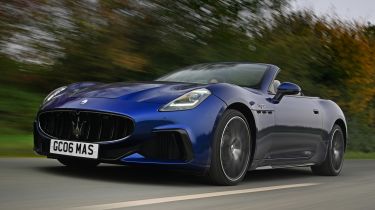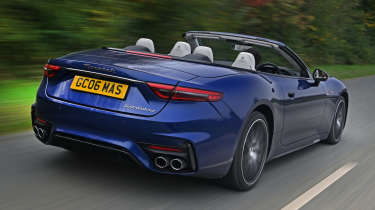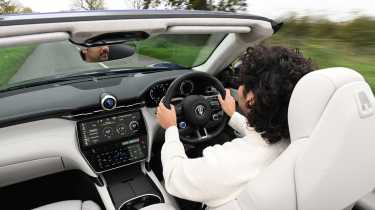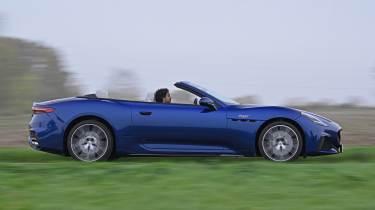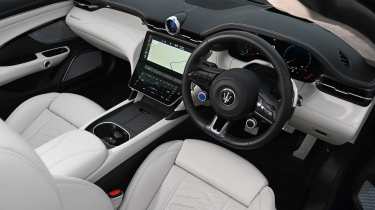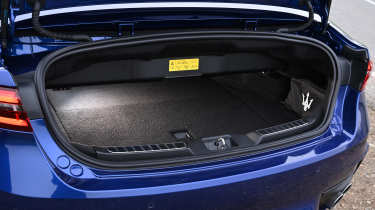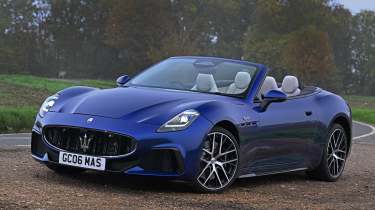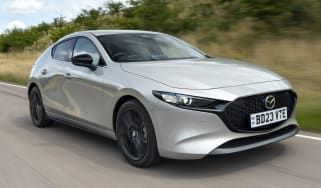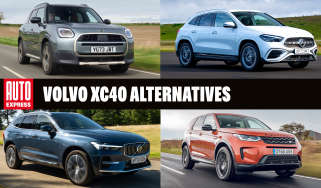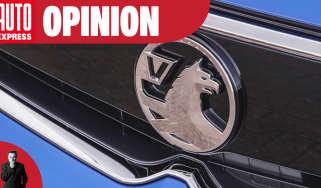Maserati GranCabrio review
Elegant open-top grand tourers might not really be in fashion right now, but Maserati has hit the bullseye with its superb GranCabrio

Is the Maserati GranCabrio a good car?
The open-top Maserati GranCabrio is a comfortable and elegant cruiser that’s surprisingly engaging to drive and has very few direct rivals. We’re not sure the high-spec and high-priced Trofeo model is the best variant to be translated to an open-top from the Coupe, but the all-electric Folgore makes for a unique and very desirable proposition.
| Key specs | |
| Fuel type | Petrol, full-electric |
| Body style | Two-door convertible |
| Powertrain(s) | 3.0-litre V6 twin turbo, all-wheel drive; tri-motor electric, all-wheel drive |
| Safety | NA |
| Warranty | 3yrs/60,000 miles |
How much does the Maserati GranCabrio cost?
Maserati has been ambitious with the price point of its new open-top GranCabrio, given that prices kick off at £165,625. With plenty of headroom for options and excruciatingly expensive optional paint finishes, the GranCabrio Trofeo just lacks the detailing and specialness one would hope for at the price.
The all-electric Folgore version is even more expensive at £185,610, but while there is a sense the technology could date, there is some novelty factor in this being the only all-electric four-seat luxury convertible on sale right now.
An open-top version of the less pricey GranTurismo Modena derivative would be a worthy addition in our opinion, but it’s the only variant of the coupé that’s not available sans roof. At something like £135,000, a Maserati GranCabrio would make an even more compelling package.
Engines, performance & drive
| Model | Power | 0-62mph | Top speed |
| Maserati GranCabrio Trofeo | 542bhp | 3.6 seconds | 196mph |
| Maserati GranCabrio Folgore | 750bhp | 2.8 seconds | 180mph |
Under that elegant body you'll find a pair of powertrains that operate right at the two ends of the high-performance spectrum. In both cases, gone is the previous model’s V8 engine – a hallmark of nearly all open-top GT Maseratis thus far – and in one model its place is taken by a 3.0-litre twin-turbocharged V6.
More reviews
While it shares its foundations with an Alfa Romeo motor, this Nettuno unit is unique to Maserati by virtue of a clever pre-combustion system that helps liberate 542bhp in Trofeo spec, plus 650Nm of torque.
So while many will bemoan the lack of an eight-cylinder shrill, in its place is far more accessible performance. And this, combined with an eight-speed automatic transmission and a clever all-wheel drive system, makes this car feel infinitely more dynamic and engaging than its predecessor.
Yes, the engine can be a touch grumbly and diesel-like at low revs, and the eight-speed automatic transmission might lack the ultimate crispness of some rival gearboxes, but we feel this to be a worthwhile compromise considering the excellent performance on offer. The Maserati feels every bit as fast as its 3.6-second 0-62mph time suggests.
But these sharp dynamics come courtesy of more than just the powertrain. That all-wheel drive system is superbly tuned too, and gives the GranCabrio excellent traction and security on slippery surfaces without compromising on a distinctly rear-drive feel. Not only that, the standard-fit air suspension also offers excellent ride quality and control, and can neatly tighten up when one of the GranCabrio’s sportier modes is selected.
If the road surface isn’t suited to a firmer setting, the quick-access bumpy road button makes it a cinch to adjust the dampers back to a softer setting without giving up on the more aggressive throttle and transmission mapping. There is a touch of scuttle shake over really rough roads, and the ride can have a slight edge over sharp ridges, but overall the car drives much better than any previous GranCabrio. It even finds a better balance between comfort and control than its Aston Martin DB12 Volante rival.
It’s the Folgore version’s all-electric powertrain that’s much more ambitious, though. Its on-paper specs are pretty impressive, with maximum outputs of 750bhp and 1,350Nm of torque produced via the three motors that draw from a 92.5kWh (gross) battery pack. Each motor is capable of 394bhp, creating a theoretical 1,182bhp total, but the battery is the limiting factor here.
Performance is still beyond what is strictly necessary for anything with four wheels, reaching 62mph in 2.8 seconds and 124mph in 9.1 seconds; top speed is a touch under 180mph. In reality it doesn’t often feel this fast, because those figures can only be achieved in the full-fat ‘Corsa’ mode. But when you wish for it, this car’s turn of pace can be quite something, and makes big speeds feel easy to achieve.
On the scales, the Folgore’s 2,340kg weight is a big number, but it’s worth remembering the latest plug-in hybrid Bentley Continental GTC is a 2,636kg car, making the all-electric Maserati seem like a comparative superlight – or superleggera if you prefer.
So while the agility and lightness of touch that define the petrol-powered coupe are missing in this open-top car, in its place is an even more resolved take on its GT credentials. This starts with the ride quality. All Folgore models run on the same air-suspension system as the ICE cars, and with that are a set of adaptive dampers and variable ride height, giving the ride quality a very wide operating window.
When in GT or Comfort mode, the ride is incredibly plush and well controlled. There’s none of the lateral wobble that can sometimes resonate in these systems, and there seems to be lots of travel that’s able to contain and control the car’s vast weight without much effort. The EV-specific high-performance Michelin tyres play their own part, too, with a rounder shoulder and more stiffness to the tyre structure giving it a touch more pliancy over sharper bumps and intrusions.
Switch through to Sport and Corsa modes and there is an appreciable improvement in roll support as the body hunkers down on its air springs. As speeds rise, you can feel the suspension working harder to control and contain the body’s overall mass, but it never goes as far feeling uncomfortable – although aggressive undulations can catch out the nose or underbody when the suspension is on its lowest setting. Being a modern Maserati, you can also disconnect the dampers from the rest of the drive modes through a switch on the steering wheel, giving you access to maximum power with a more compliant ride.
The really impressive part, though, is that regardless of which setting you’re in there’s always a sense of stiffness from the structure, which is very impressive considering the big, open four-seat cabin layout. The steering is a touch heavier than in the petrol cars, which is no bad thing, and thanks to the clever T-shaped battery pack, it feels as if you’re sitting among the weight of the car, rather than on top of it.
There’s no ignoring the Folgore’s sheer mass, however. It always needs some level of management, and despite good rather than great brake feel, you also need to keep on top of the inertia when pushing on. You can, if you’re feeling particularly ambitious, take advantage of the true-torque vectoring on the rear axle, but it’s never really comfortable at this higher pace.
However, when you do slow things down a bit, drop the roof and enjoy the wonderfully appointed cabin, its Italian handbag-quality leather strewn across almost every surface, and the quite excellent level of protection from wind buffeting, it’s clear that Maserati has this car nailed in the aspects that it knows its customers will appreciate.
MPG, CO2 & running costs
| Model | MPG/Range | CO2/charging | Insurance group |
| Maserati GranCabrio Trofeo | 26.7 | 240 | 50 |
| Maserati GranCabrio Folgore | 275-mile range | 250kW charging | 50 |
No luxury four-seat cabriolet is going to be sold or rejected because of its fuel consumption, but it seems that regardless of the downsized engine, fuel consumption on the Trofeo is high. In fact, we struggled to get close to the 26.7mpg official figure, barely breaking 20mpg over the course of a few days.
The Folgore’s range isn’t too bad considering the pace on offer, with a theoretical maximum of around 275 miles. It’ll charge from 10-80 per cent in around 18 minutes thanks to a peak 270kW rate. Driving over a more challenging selection of roads in the Italian sunshine we saw levels of efficiency that would equate more to around 200 miles.
Design, interior & technology
There’s a question mark over whether the interior is opulent enough considering the car’s elegant mantra. For the most part, Maserati’s superb leather – and the tendency to use it to cover nearly every interior surface – is a pleasant aspect. However, the underlying cabin quality is still a little thin, and the GranCabrio lacks the extraordinary detailing and bespoke touches that rivals from Bentley or Aston Martin capitalise on.
Whereas previous GranCabrios with the duo-select transmission used to feature a small but solid metal toggle switch to engage forward or reverse gears, the new car’s plastic buttons feel no more special than those on a Fiat 500. And don’t get us started on needing to put a dirty great big swipe mark on the lower touchscreen to put the roof up and down.
Sat-nav, stereo and infotainment
The infotainment system is also a disappointment, despite feeling capable and modern. It doesn’t do much to hide its connection to lesser Maserati models, not to mention the Alfa Romeos and Fiats that also share the underlying hardware. The main touchscreen is relatively easy to operate and quickly connects to your smartphone if the embedded interface isn’t to your liking.
Sitting below is a second touchscreen that controls the air-conditioning, as well as most other controls, such as the lighting, roof and digital clockface, but we can’t help missing some of the physical controls that help expensive cars like this feel special.
Boot space, comfort & practicality
| Dimensions | |
| Length | 4,966mm |
| Width | 2,113mm |
| Height | 1,365mm |
| Number of seats | Four |
| Boot space | 131-117 litres |
However, something that hasn’t changed over the last generation is the distinction of offering four full-sized seats for adults. With the possible exception of a Rolls-Royce Dawn, this is unheard of in today’s open-top GT market. In purely practical terms, though, you’ll have to compromise on the available bootspace, because the huge folding roof means it’s reduced to a tiny 131 litres with the roof down, and just 117 litres in the Folgore. At least wind buffeting is well controlled, especially with the wind-deflector in place.
Safety & reliability
| Key standard safety features | Euro NCAP safety ratings |
|
|
There’s no reason to undermine the GrabCabrio’s safety record, and being a modern European car, it includes all the usual active features. There is a system that will jettison a roll hoop if the car senses a roll-over, for instance, but there’s no official Euro NCAP rating given the car’s low sales figures. Maserati’s reliability record is one to look at a little more closely, though, because the brand doesn’t have a great track record.
Maserati GranCabrio alternatives
Four-seat luxury convertibles aren’t quite as popular as they once were, but there are still a few models that could be seen as rivals. For example, Bentley’s new Continental GT Speed Convertible is one that’s admittedly bigger and quite a lot more expensive. This is a halfway house between the pure-petrol and pure-electric models offered by Maserati, and offers a very impressive driving experience to boot. Less expensive Continental GT Convertible models will be on stream soon.
From here, though, the rear seats of most rivals become more of a coat rest. Aston Martin’s DB12 is a more dynamic alternative, lacking the Maserati’s plush ride, but it comes with an even more high-end feel and a charismatic V8 engine. The Mercedes SL is less plush inside, but while it comes with more tech, it also has less overt character.

